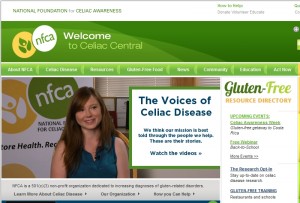Tag Archive
About.com Amazing Gluten Free Chocolate Art of Gluten Free Baking breakfast celiac disease Chef Amber Shea chia seeds chocolate Christmas Cookies coconut Coconut Aminos coconut milk cookies Dairy Free Diet, Health and Gluten Dr. Mark Hyman Dr. Vikki Petersen entree flexitarian gluten free gluten free grains Gluten Free Pasta Salad Gluten Free Vegan gluten free vegan recipe Gluten free vegan recipes Happy Herbivore Holiday Cookies Jane Anderson Jules Gluten Free Jules Shepard Jules Shephard Lindsay Nixon Living Without meat substitutes new products pumpkin quinoa raw food Salad Sandy's recipe Sandy's recipes snacks vegan vegenaise where to eat gluten free
New Gluten Free Labeling
Earlier this month, U.S. Food and Drug Administration (FDA) finalized a standard definition of “gluten-free”.
So what does it mean, exactly, when a food product is labeled as ‘gluten-free” and what is the gluten free labeling requirements? According to the National Foundation of Celiac Awareness (NFCA) ….
FDA Gluten-Free Labeling Rule
Under the new rule, if a food carries a gluten-free claim, it either:
- Inherently does not contain gluten (i.e. a bag of raw carrots or bottle water)
OR meets the following criteria:
- Does not contain an ingredient that is a whole, gluten-containing grain (i.e. wheat, barely, rye or crossbred hybrids of these grains)
- Does not contain an ingredient that is derived from a gluten-containing grain and has not been processed to remove gluten (i.e. wheat flour)
- May contain an ingredient that is derived from a gluten-containing grain that has been processed to remove gluten (i.e. wheat starch) as long as the food product contains less than 20 parts per million (ppm) of gluten
AND
- Any unavoidable gluten in the food due to cross-contact (commonly referred to as cross-contamination by the gluten-free community) or migration of gluten from packaging materials is less than 20 ppm gluten
The NFCA has put together a Follow Up Fact Sheet which I found to be very helpful.
Some of the interesting fact addressed in this report is as follows:
Q: Under the FDA’s final gluten-free labeling rule, oats are NOT considered a gluten-containing grain. Does this mean that oats are safe to consume on a gluten-free diet?
Q: Why is wheat starch allowed in products that are labeled gluten-free?
Q: It’s unclear to me whether I should still steer clear of products containing malt and hydrolyzed wheat protein. What does the FDA’s gluten-free labeling rule say about these ingredients? For example, can I eat soy sauce?
Q: While I understand that less than 20 ppm gluten is less than a crumb and, therefore, not visible to the eye, I still have several questions about this amount. Can you…
1.Help put this into context for me?
2.Clarify whether I should be concerned with cumulated gluten intake?
3.Explain how many servings of less than 20 ppm can a person with celiac disease safely consume in one day?
Q: What vinegar, if any, is safe to eat on a gluten-free diet?
Q: I know that you recommend purchasing naturally gluten-free grains and flours and grain and flour-based products that are labeled gluten-free. Are there other dry food products that might fall into this category? For example, what about seeds, beans and nuts?
Q: Does this ruling mean that the products labeled gluten-free now aren’t under 20 ppm?
Q: I know that we have to start somewhere, but I don’t understand the significance of the rule if it’s not mandatory and manufacturers aren’t required to test. How does this rule impact people on a medically necessary gluten-free diet as opposed to individuals “riding out the fad”?
Q: If a product is now labeled gluten-free but its label says that it is “processed in a facility that also processes
wheat,” is this product really gluten-free?



